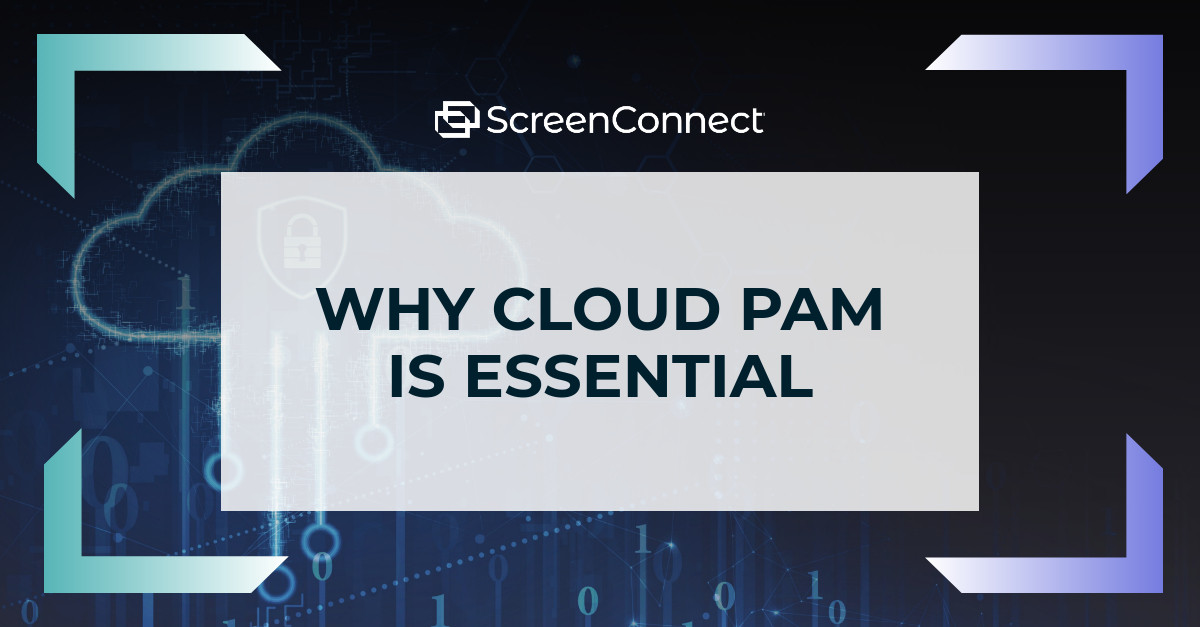Cloud PAM: Why cloud privileged access is essential in the age of credential attacks

Cybercriminals no longer need to smash firewalls or exploit obscure vulnerabilities—they just log in. Stolen, misused, or over-provisioned credentials give attackers all the access they need. Once inside, they can escalate privileges, move laterally across systems, and operate under the radar of traditional defenses.
This shift has made privileged accounts one of the most valuable targets in any IT environment. In fact, according to Verizon’s 2025 Data Breach Investigations Report, about 60% of cybersecurity breaches are tied to human error, with credential abuse cited as a significant factor in these incidents.
Yet despite this risk, many organizations still operate on standing privileges—users retain high-level access even when they’re not actively using it. This creates a massive security gap and forces IT and MSP teams into an impossible trade-off: maintain productivity with broad administrative rights or secure the environment by restricting access in ways that cripple workflow.
The solution isn’t a more complex infrastructure—it’s a smarter access control strategy. Cloud-based PAM makes it possible to enforce least privilege access in a way that strengthens security and preserves productivity. Cloud PAM is faster to roll out, easier to manage at scale, and designed to adapt to hybrid and distributed environments without the burden of maintaining additional infrastructure.
This article dives into the pros and cons of privileged access management (PAM) and discusses common use cases and considerations for choosing a PAM solution.
Key takeaways
- Implementing a privileged access management (PAM) solution can help improve an organization’s security posture by enforcing the principle of least privilege access.
- PAM software helps proactively mitigate risks and human errors that commonly lead to security breaches, such as shared passwords and excessive admin rights.
- Cloud PAM is a flexible, scalable means of deploying privileged account management via the cloud, without the complexity or upfront costs associated with traditional on-prem deployments.
- Benefits of cloud privileged access management include simplified management, lower maintenance, faster deployment, increased scalability as business needs evolve, and tighter integration with existing IT workflows.
Cloud PAM vs. legacy on-premise PAM
Traditional privileged access management tools have catered more toward on-premise environments, which deliver strong security but typically require heavy infrastructure, complex upgrades, and constant upkeep—a significant burden for IT teams already stretched thin. Standing up a self-hosted solution often means weeks or months of deployment, high upfront costs, and ongoing maintenance just to keep the system running.
Even after go-live, scaling these solutions is difficult. Adding new servers, users, or applications usually means adding more infrastructure and repeating the same configuration work. And if teams fall behind on maintenance or configuration, the very system designed to protect privileged accounts can itself become a source of risk.
By contrast, privileged access management cloud solutions deliver the same core protections without the overhead. There’s no hardware to maintain, no vaults of static credentials to be stolen, and no jump-boxes to slow users down. Access is provisioned just-in-time with credential-free, temporary logins that expire automatically, leaving nothing behind for attackers to exploit. Deployment is measured in hours, not months, and scaling is as simple as adding new endpoints or users. This agility makes cloud PAM particularly valuable for organizations shifting workloads into cloud or hybrid environments, where speed and flexibility are critical.
Components of cloud PAM
PAM delivered as a cloud-hosted service is fundamentally different from legacy, on-premises tools. Instead of relying on static accounts, hardware vaults, or manual oversight, cloud privileged access management enforces least privilege in real time while fitting naturally into IT workflows. At its core, service-based PAM is built on a few essential capabilities:
- Ephemeral access
Privileged sessions are temporary by design. Instead of relying on permanent admin accounts or password vaults, access is provisioned just-in-time and automatically expires when no longer needed.
- Privilege elevation on demand
End users can request elevated rights for specific tasks, with approvals routed in real time. This ensures users get the access they need without leaving standing privileges behind.
- Policy-driven automation
Common access decisions—such as approving trusted applications or blocking known risks—can be automated with conditional rules. This reduces manual workload while enforcing least privilege consistently.
- Audit and visibility
Every request and approval is logged with context, creating a clear audit trail that supports compliance and simplifies investigations when questions arise.
- Cloud-native scalability
With the service delivered as a hosted solution, IT teams don’t need to manage extra infrastructure or jump-boxes. Scaling to new endpoints or user groups is faster and requires fewer resources.
- Integrations with IT and support ecosystems
Cloud PAM connects directly with the tools IT and MSP teams already use, from service desks and RMM platforms to collaboration channels like Slack or Teams. This ensures privileged access is managed in the flow of work, not in a separate silo.
Together, these components replace permanent, high-risk admin rights with precise, auditable, and time-bound access. The result is stronger security paired with a better experience for both users and IT.
Why cloud-hosted PAM is important
For many IT and MSP teams, privileged access has long felt like a no-win trade-off: grant broad admin rights so users can stay productive or restrict privileges so tightly that workflows grind to a halt. The result is a patchwork of standing accounts, inconsistent approvals, and frustrated employees who often find risky workarounds just to keep moving.
With compromised credentials behind nearly half of all data breaches (49%), this balancing act has become unsustainable. Organizations can’t afford to leave privileged accounts exposed, yet they also can’t afford security controls that slow the business down.
The pressure isn’t just from attackers. Many cyber insurance providers now require organizations to demonstrate privileged access controls before granting coverage. Without a PAM solution, companies may be unable to qualify or stuck with limited policies that leave them vulnerable to data breaches.
For IT departments seeking hosted solutions, cloud PAM delivers privileged access management without the burden of on-premise infrastructure—offering tighter control, faster deployment, and scalability.
Cloud PAM use cases
The flexibility of cloud privileged access management makes it ideal for a range of industries and scenarios.
Managing multiple client environments. For teams supporting diverse customers, cloud PAM centralizes oversight and simplifies how privileged accounts are controlled without requiring separate setups for each customer.
Meeting compliance in regulated industries. Highly regulated sectors such as healthcare, finance, and government face strict oversight. Automated audit trails and real-time reporting help meet compliance requirements while reducing the manual effort IT teams usually spend on documentation.
Supporting remote and hybrid workforces. As employees connect from anywhere, just-in-time (JIT), credential-free access allows them to stay productive without exposing permanent admin accounts. PAM helps organizations secure endpoints without slowing down work.
Adapting to rapid growth. Fast-scaling businesses can’t afford access controls that lag behind expansion. Cloud PAM scales effortlessly with new users, endpoints, and policies, keeping controls aligned as the business evolves.
Common challenges with cloud PAM execution
While cloud PAM delivers strong security benefits, implementation can still feel overwhelming when your team’s already stretched thin. Some solutions demand lengthy setup cycles or steep learning curves, ironically adding complexity instead of reducing it.
One of the biggest challenges is coverage and integration. PAM often works smoothly in small-scale deployments, but extending it across service accounts, legacy applications, and poorly documented systems can feel like an uphill climb. Without a clear inventory of where privileged accounts live and how they’re used, gaps are inevitable—and those gaps are exactly what attackers look to exploit.
Another common issue is overprovisioning. Without tight controls, users may accumulate unnecessary privileges over time (known as privilege creep). This creates excess risk and complicates compliance audits. Slow approval workflows can also frustrate employees who need access to complete urgent tasks, driving risky shortcuts.
Resilience is another key concern. If a PAM system goes down, admins risk being locked out of the very systems they need to manage in a crisis. Any implementation plan should include contingencies for “break-glass” access to ensure business continuity.
Fortunately, these challenges are manageable with the right approach. Using a privileged access policy checklist can help establish guardrails from the start, while following best practices for privileged management and choosing the right software provider can keep execution on track.
Implementing cloud PAM with ScreenConnect
Whether you’re an MSP managing multiple client environments or an internal IT team securing your own infrastructure, ScreenConnect Privileged Access is a cloud-hosted PAM solution designed for flexibility and scale. It enables credential-free admin access, real-time approvals, and seamless integrations with the tools you already use.
If you’re exploring cloud PAM, you can get started right away: start a free trial today and put these capabilities to work in your own environment. To make the most of it, our 14-Day Trial Playbook walks you through how to evaluate cloud PAM in your own environment, from handling your first elevation request to demonstrating audit-ready oversight.
For teams looking to build the business case, our PAM calculator helps estimate how much time and cost savings cloud PAM can deliver.
Learn more about privileged access management software
Ready to simplify your privileged access management? Learn more about our privileged access management software.
FAQs
How does Cloud PAM differ from traditional PAM solutions?
Traditional PAM often requires on-premise infrastructure, complex deployments, and ongoing maintenance. Cloud PAM delivers the same protections, such as privileged access controls and audit trails, through lightweight, flexible, cloud-native tools. This makes it faster to implement, easier to scale, and more cost-effective for IT teams and MSPs managing modern environments.
What are the key benefits of implementing Cloud PAM?
Cloud PAM strengthens security by eliminating shared credentials, enforcing just-in-time access, and maintaining detailed audit logs. It reduces IT workload with automation, integrates with tools like Slack and Teams, and helps meet compliance requirements.
What types of privileged accounts can Cloud PAM protect?
Cloud PAM can secure administrator, root, service, and application accounts—any identity with elevated privileges that could be targeted by attackers.
Is Cloud PAM scalable for large enterprise environments?
Yes. Cloud PAM is built to scale with organizational needs, from small teams managing multiple environments to global enterprises supporting thousands of privileged users. Its cloud-native design ensures access policies, approvals, and audit logs grow seamlessly with the business without additional infrastructure investments.
What are common use cases for Cloud PAM?
Cloud PAM is valuable across industries and scenarios, including compliance-driven sectors like finance or healthcare, and organizations with remote or hybrid workforces. It’s also critical for fast-scaling businesses that need flexible, just-in-time access controls without slowing operations or creating bottlenecks.
